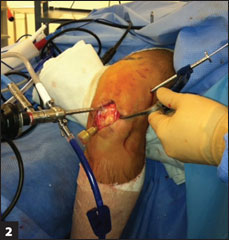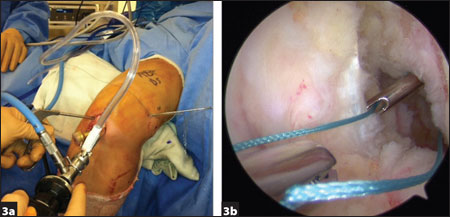Interference screws in femoral bone block fixation may avoid lateral knee incision
Click Here to Manage Email Alerts
ACL reconstruction is a widely accepted treatment for patients who have instability symptoms from ACL deficiency and desire to resume activity. Surgical reconstruction may be appropriate, for many of the 200,000 injured athletes every year. There are various grafts that may be used to replace the ACL. However, grafts that feature bone blocks on one or both sides of tendon material, such as bone-patella tendon-bone (or bone-to-bone grafts), have been suggested to heal more rapidly to the surrounding boney tunnels. These grafts may allow for more aggressive, faster rehabilitation than soft-tissue grafts. Secure, relatively inexpensive, immediate bone block fixation with metal interference screws has been a reliable option in ACL reconstruction for many surgeons during the past 3 decades.
ACL reconstruction techniques have evolved to achieve a more anatomic graft placement, which may significantly improve postoperative rotational stability. For a single-bundle construct, this requires centering graft tunnels within the ACL footprint that incorporate portions of both anteromedial and posterolateral bundles. In order to achieve this tunnel placement, many authors advocate the use of independent femoral tunnel drilling to avoid the constraints of reaming through the tibial tunnel.

R. Brick Campbell

William Marshall
The two-incision technique popularized in the 1980s allows for independent femoral tunnel positioning, but requires a formal lateral femoral incision to visualize an outside-in interference screw placement. However, alternative independent tunnel techniques that do not require a lateral knee incision (anteromedial portal for tunnel placement) and fixation options (inside-out screw fixation, suspensory devices) have drawbacks as well. Achieving the reliable interference screw fixation with a simple outside-in delivery, yet avoiding a formal second incision, may provide another suitable ACL reconstruction option.
This Surgical Technique describes a simple, inexpensive, reproducible strategy to complete fixation of the femoral bone block in ACL reconstruction, while using independently created tunnels with an outside-in approach and eliminating the formal lateral knee incision.
Femoral bone block fixation
Prior to a standard arthroscopic inspection of the knee and treatment of concomitant pathology, ACL reconstruction is initiated using patella bone-tendon-bone graft harvesting in usual standard techniques. Alternatively, quadriceps tendon-bone autograft and Achilles allograft, which allow for bone-to-bone fixation, may be used. The most proximal bone tip of the graft is routinely marked to allow identification of the non-tendinous side of the block (Figure 1). This mark will be visualized in the femoral tunnel by using an arthroscope, which allows targeted interdigitation of the guide pin between the desired side of the bone block and the tunnel wall; this is typically done for the open two-incision technique for femur or tibia fixation.

Images: Campbell RB

While the graft is being prepared, the surgeon may proceed to drill the tibial and femoral tunnels. Standard techniques are used for drilling of the tibial tunnel. Femoral tunnel positioning is facilitated with an outside-in guide (Figure 2), using a small stab wound over the distal lateral thigh for the guide pin sleeve. Inside-out techniques could be used as well, if the femoral tunnel is reamed to include the lateral cortex. A tourniquet is not routinely used for any step in this procedure except the graft harvest.



The femoral tunnel should be meticulously positioned in order to encompass adequate portions of both anteromedial and posterolateral bundles with the surgeon’s choice of femoral guides, which may be outside-in or inside-out directionally. We recommend using an outside-in guide, such as the one pictured below to simplify the procedure (Figure 2).
Once the femoral drill pin is placed, the femoral tunnel is created with a standard reamer to include the lateral femoral cortex. A sturdy passing suture is delivered through the tunnels and across the knee joint to guide the graft into position (Figure 3). The graft may be rotated to the surgeon’s preferred orientation to achieve better approximation over the two ACL bundles. The graft is advanced to improve bone block/bone tunnel overlap and orifice fixation as desired.
To pass the suture through the femoral tunnel, we recommend passing a suction shaver down the femoral tunnel from outside-in to clear out bone debris and remove soft tissue from the tunnel orifice prior to placing the passing suture, which will enhance visualization of the tunnel. This will also improve muscle memory for placement of the passing suture, guide pin and arthroscope into the femoral tunnel once the graft is passed.

Shown is an endoscopic view of a partially advanced interference screw.

Shown is an endoscopic view of a fully advanced interference screw.
When the guide pin is adequately positioned, an interference screw is slowly advanced. Placement of the screw is re-checked for accuracy (Figure 6) and advanced until flush with the bone block (Figure 7).
After passing the graft, hold the femoral bone block sutures under tension and place the arthroscope into the lateral thigh stab wound. Follow the sutures down through the IT band and into the tunnel and flush out any remaining bone debris until marks on bone block can be seen (Figure 4). While under endoscopic visualization, a guide pin is positioned relative to the mark previously colored on the graft (Figure 5). Alternatively, the pin may be placed in the femoral tunnel before the leading bone block is passed, as long as graft advancement is not hindered.
To position the guide pin, we recommend placing the pin parallel to the tensioned sutures; this can be done with or without an arthroscopic view. Once the guide pin is in the tunnel, slightly angle the pin across the canal to deliver the pin into the proper location between the bone block and tunnel. Delivery of the pin may be aided by use of a meniscal repair device skid.

Shown is the final ACL graft position.

Shown is the healed stab wound on the lateral thigh at 4 months postoperatively.
When the guide pin is adequately positioned, an interference screw is slowly advanced. Placement of the screw is re-checked for accuracy (Figure 6) and advanced until flush with the bone block (Figure 7).
To advance the interference screw, we recommend partially rotating the screwdriver in a back-and-forth motion as the screw settles over the guide pin; this avoids the cutting of the suture. While the suture is rarely damaged, the screw is usually engaged enough to continue the technique without re-threading. Seven to 12 full turns will fully seat a 7x20-mm interference screw. Surgeons should re-check and assess screw positioning after seven turns. Once the graft is fully secured, the intra-articular view is re-established to verify graft position and to assure the screws have not entered the notch (Figure 8).
Advantages
In summary, this simple technique provides anatomic placement of the graft, strong orifice fixation and acceptable cosmesis (Figure 9), which may lead to faster recovery and greater patient satisfaction.
In addition to these advantages, the relatively quick learning curve and inexpensive nature of this technique are beneficial for the surgeon, patient and surgery center. Alternative fixation devices may cost three- to four-times the price of a metal interference screw.
- References:
- Bowers AL, et al. Arthroscopy. 2011;doi:10.1016/j.arthro.2011.07.007.
- Hewett TE, et al. 2007. Understanding and Preventing Noncontact ACL Injuries. Champaign, IL: Human Kinetics Publishers.
- Kurosaka M, et al. Am J Sports Med. 1987;doi:10.1177/036354658701500306.
- Musahl V, et al. Am J of Sports Med. 2005;doi:/10.1177/0363546504271747.
- Owens, et al. Am J Sports Med. 2013; doi:10.1177/0363546513511052.
- Park MJ, et al. Int Orthop. 2001;doi:10.1007/s002640000199.
- Princess Anne Ambulatory Surgery Center, Virginia Beach, VA. Personal Communication
- Prodromos CC, et al. 2007. The Anterior Cruciate Ligament: Reconstruction and Basic Science. Philadelphia, PA: Saunders/Elsevier.
- Steiner ME, et al. Am J Sports Med. 2009; doi:10.1177/0363546509340407.
- Steiner ME. J Knee Surg. 2009;doi:10.1055/s-0030-1247745.
- Tomita F, et al. Arthroscopy. 2001; doi:10.1053/jars.2001.24059.
- For more information:
- R. Brick Campbell, MD, can be reached at Virginia Institute for Sports Medicine, 1849 Old Donation Dr., Virginia Beach, VA 23454; email: ladbrick@cox.net.
- William Marshall, BS, can be reached at 2445 Brasileno Dr., Virginia Beach, VA 23456; email: billyamarshall@gmail.com.
Disclosures: Campbell reports he received research support from Smith & Nephew and Arthrex and is a consultant and receives royalties from Arthrex. Marshall reports no relevant financial disclosures.
